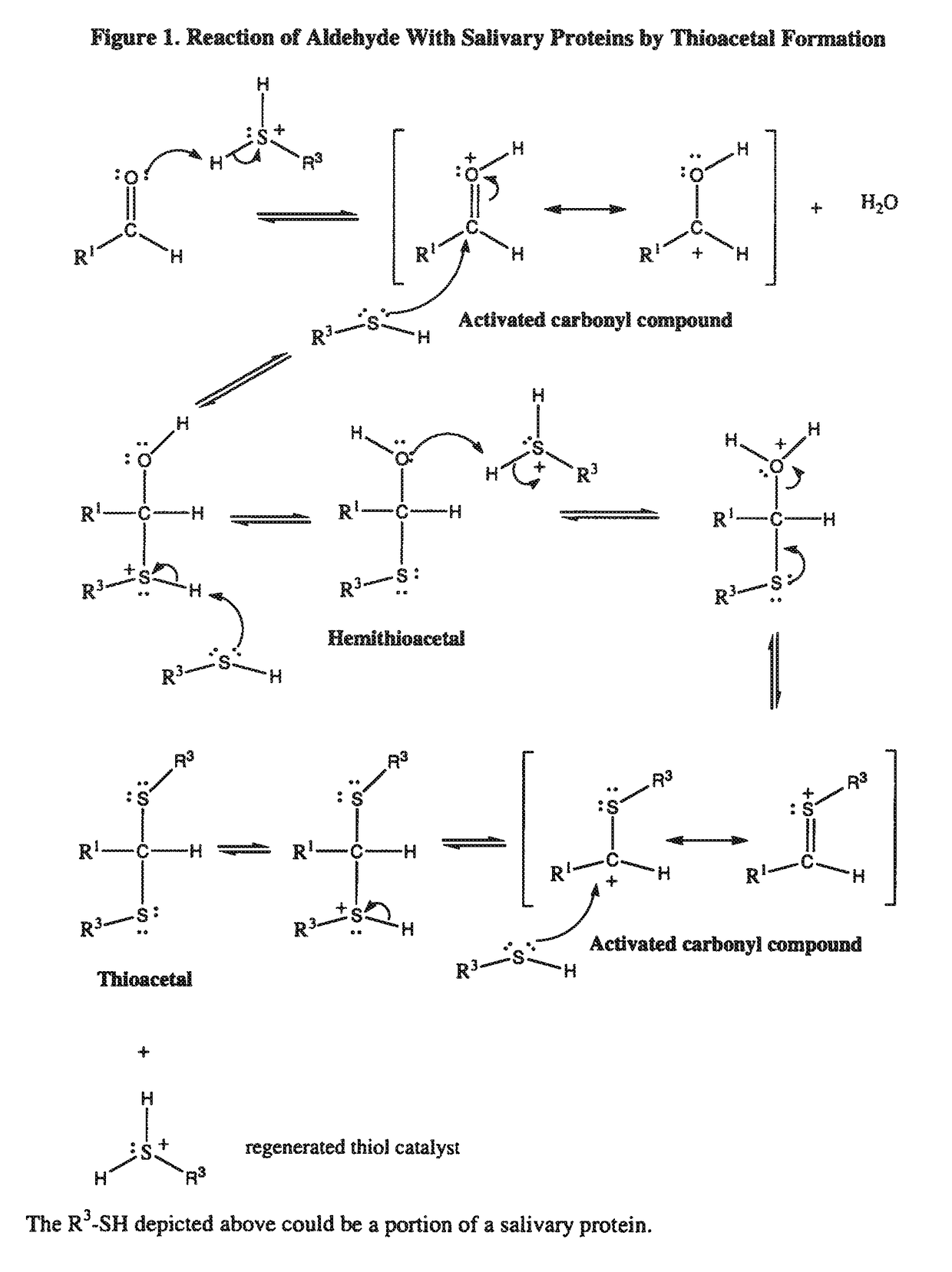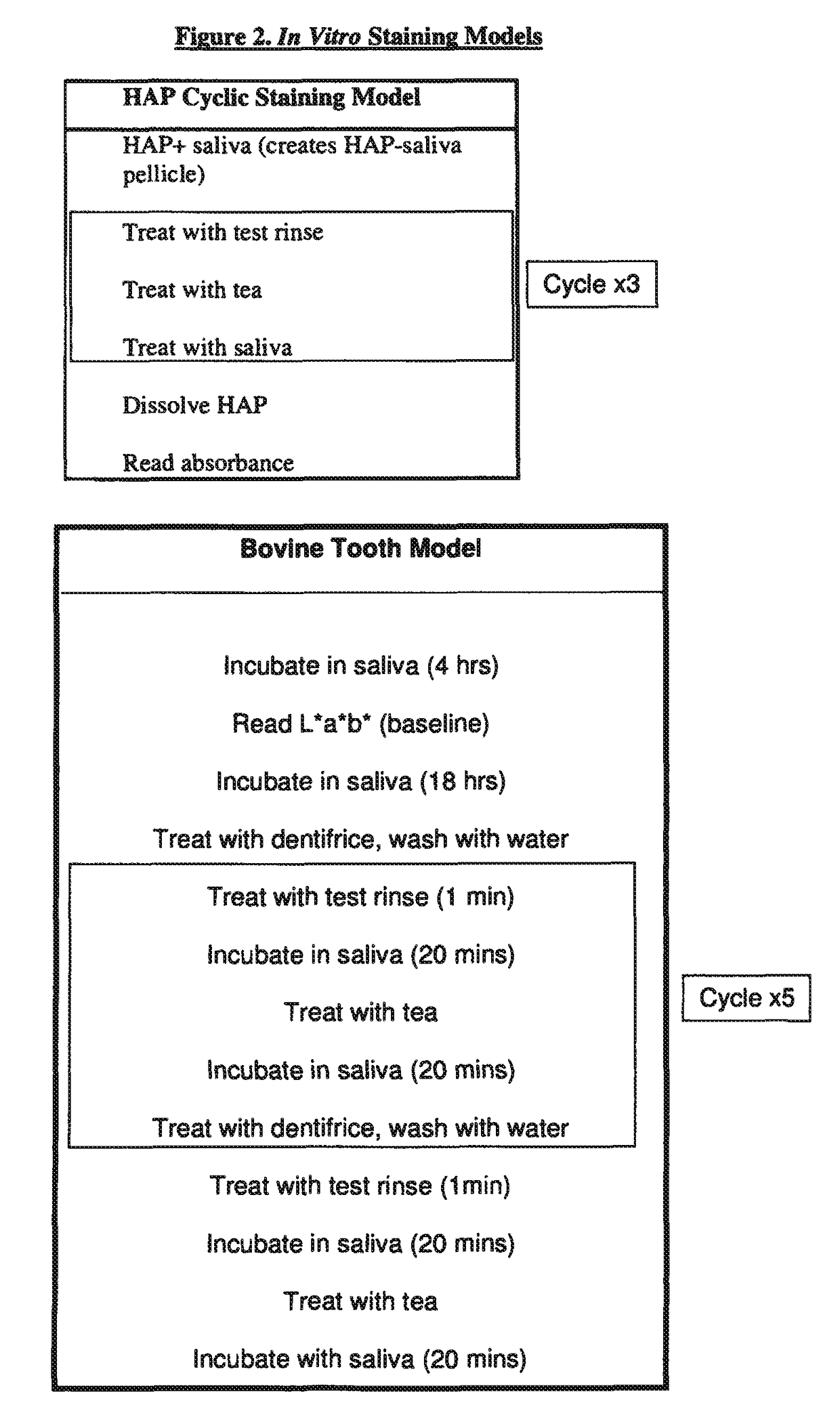Reduction of tooth staining derived from cationic antimicrobials
a technology of cationic antimicrobials and tooth staining, applied in the field of oral care compositions, can solve the problems of significant affecting the aesthetic appearance of teeth, low concentration of bleaches added to oral care products, and gum disease, and achieve the effects of reducing the number of tooth stainings
Active Publication Date: 2018-11-13
PROCTER & GAMBLE CO
View PDF64 Cites 5 Cited by
- Summary
- Abstract
- Description
- Claims
- Application Information
AI Technical Summary
Benefits of technology
The combination effectively reduces tooth staining by minimizing protein interaction with cationic antimicrobials, maintaining their bioavailability and antimicrobial efficacy, and providing enhanced oral hygiene while controlling plaque and calculus proliferation.
Problems solved by technology
The formation of dental plaque and calculus and failure to stop their proliferation are the primary cause of dental caries, gingivitis, periodontal disease, and tooth loss.
Calculus and plaque along with behavioral and environmental factors lead to formation of dental stains, significantly affecting the aesthetic appearance of teeth.
However, bleaches added to oral care products are typically present in low concentrations due to stability and safety limits.
At these low concentrations, bleaches such as peroxide, are generally ineffective to control stain and whiten teeth.
Furthermore, bleaches do not functionally act to prevent acquisition of stains.
Method used
the structure of the environmentally friendly knitted fabric provided by the present invention; figure 2 Flow chart of the yarn wrapping machine for environmentally friendly knitted fabrics and storage devices; image 3 Is the parameter map of the yarn covering machine
View moreImage
Smart Image Click on the blue labels to locate them in the text.
Smart ImageViewing Examples
Examples
Experimental program
Comparison scheme
Effect test
examples
[0134]The following examples further describe and demonstrate embodiments within the scope of the present invention. These examples are given solely for the purpose of illustration and are not to be construed as limitations of the present invention.
example i
Mouth Rinse Compositions
[0135]Mouth rinse compositions A-F according to the present invention made using conventional methods are shown below with amounts of components in weight %.
the structure of the environmentally friendly knitted fabric provided by the present invention; figure 2 Flow chart of the yarn wrapping machine for environmentally friendly knitted fabrics and storage devices; image 3 Is the parameter map of the yarn covering machine
Login to View More PUM
 Login to View More
Login to View More Abstract
Disclosed are oral care compositions having reduced tooth staining propensity and comprising in a pharmaceutically acceptable carrier, a cationic antimicrobial agent and an anti-stain agent comprising one or more materials from each of at least two of the following chemical groups:Group 1. anionic agents,Group 2. aldehydes, ketones, and other reactive carbonyl compounds andGroup 3. nonionic ethoxylated surfactants.Examples of cationic antimicrobial agent include quaternary ammonium compounds such as cetylpyridinium chloride, cetyl pyridinium fluoride, tetradecylpyridinium chloride, N-tetradecyl-4-ethyl pyridinium chloride and domiphen bromide; chlorhexidine; and metal ion sources to supply metal ions such as stannous, zinc or copper.
Description
TECHNICAL FIELD[0001]The present invention relates to oral care compositions containing an agent to eliminate or reduce tooth staining, specifically staining derived from cationic antimicrobial agents used in oral care compositions to reduce oral bacteria and to prevent and treat bacteria-mediated diseases or conditions of the oral cavity including dental plaque, caries, calculus, gingivitis, periodontal disease and breath malodor.BACKGROUND OF THE INVENTION[0002]Cationic materials which possess antimicrobial activity have been used in oral compositions to counter oral bacteria and to prevent and treat conditions caused by bacteria in the oral cavity, such as formation of dental plaque and calculus. The formation of dental plaque and calculus and failure to stop their proliferation are the primary cause of dental caries, gingivitis, periodontal disease, and tooth loss. Dental plaque is a mixed matrix of bacteria, epithelial cells, leukocytes, macrophages and other oral exudate. Bact...
Claims
the structure of the environmentally friendly knitted fabric provided by the present invention; figure 2 Flow chart of the yarn wrapping machine for environmentally friendly knitted fabrics and storage devices; image 3 Is the parameter map of the yarn covering machine
Login to View More Application Information
Patent Timeline
 Login to View More
Login to View More Patent Type & Authority Patents(United States)
IPC IPC(8): A61K8/49A61K31/721A61K8/27A61P29/00A61P1/02A61K8/73A61Q11/00A61K8/86A61K8/33A61K8/35A61K8/41A61K8/43A61Q17/00A61K8/19A61K8/55A61K31/4425
CPCA61K8/27A61K8/19A61K8/33A61K8/35A61K8/416A61Q17/005A61K8/4926A61K8/55A61K8/73A61K8/86A61Q11/00A61K8/43A61P1/02A61P29/00
Inventor RAMJI, NIRANJANSCOTT, DOUGLAS CRAIG
Owner PROCTER & GAMBLE CO
Features
- R&D
- Intellectual Property
- Life Sciences
- Materials
- Tech Scout
Why Patsnap Eureka
- Unparalleled Data Quality
- Higher Quality Content
- 60% Fewer Hallucinations
Social media
Patsnap Eureka Blog
Learn More Browse by: Latest US Patents, China's latest patents, Technical Efficacy Thesaurus, Application Domain, Technology Topic, Popular Technical Reports.
© 2025 PatSnap. All rights reserved.Legal|Privacy policy|Modern Slavery Act Transparency Statement|Sitemap|About US| Contact US: help@patsnap.com



